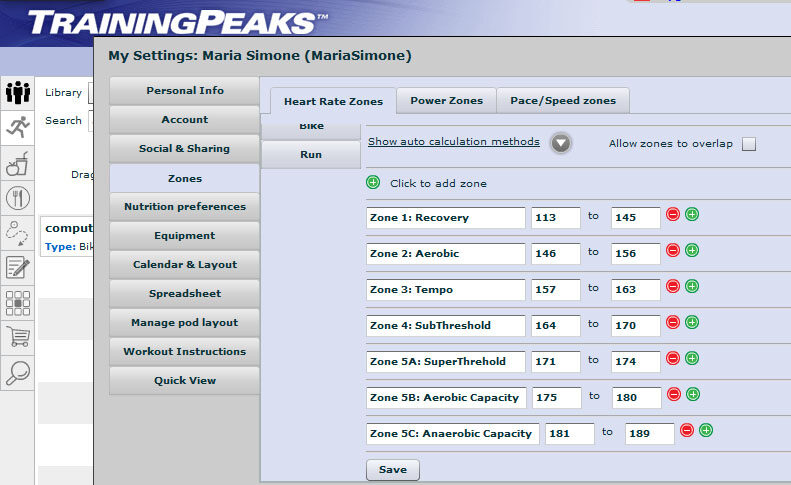 There are a variety of metrics you can – and should – use when tracking your training. For purposes of tracking your intensity – from easy to very hard – or for tracking your progress based on how much effort you’re putting in versus how much speed you are getting out, heart rate is one of the best metrics you can apply.
There are a variety of metrics you can – and should – use when tracking your training. For purposes of tracking your intensity – from easy to very hard – or for tracking your progress based on how much effort you’re putting in versus how much speed you are getting out, heart rate is one of the best metrics you can apply.
This post discusses heart rate as an assessment of your adaptation to training. It is important to note, however, that we do NOT advocate using heart rate only. At a bare minimum, heart rate should be used in combination with assessments of perceived exertion (using either a 1-10 or 1-20 scale), and subjective descriptions of how the workout felt. Ideally, heart rate is combined with pace or speed, and power (for the bike).
Measure Effort not Speed or Pace
Many athletes like to focus on their speed or pace. However, speed and pace are not always an accurate indicator of intensity. Consider how running or riding up a hill (or down a hill) will change your speed. You could be putting forth the same effort running up as hill as you would running on a flat, yet your speed would be much slower. If you only consider pace, you are not acknowledging the added stress that comes with climbing a hill.
In training and in developing a pacing strategy for racing, how hard you are working–not how fast you are going–is the most telling indicator. Heart rate gives you a more reliable indicator of how hard you are working than pace does. For athletes that race with power on their bikes, heart rate tells you the effect that power input is having on your system. When we track the relationship between heart rate and pace or heart rate and power in a single workout or over time, we can track progress.
Here are some basics for training with hear rate.
Finding your zone
The first place to start is with some baseline testing. Heart rate tests can take on several forms, including a test to approximate maximum heart rate or threshold heart rate. We don’t recommend testing for maximum heart rate because this would require an all-out effort, which can lead to injury given the high level of orthopedic stress that maximal efforts put on the body. Furthermore, max heart rate doesn’t tell us much about your lactate threshold – and this threshold is key to understanding your aerobic capacity.

A threshold test looks for a sub-maximal effort that you can maintain for a certain period of time, such as 20, 30 or 60 minutes. Threshold tests can give us an approximation of your lactate threshold – or that point at which your body shifts from using an aerobic (i.e., oxygen-based) system of energy to fuel your efforts to an anaerobic (i.e., nonoxidative) system of energy to fuel your efforts. This threshold is important because it helps us identify appropriate heart rate zones for: 1) active recovery, 2) aerobic sessions, and 3) tempo or threshold efforts.
There are a variety of different protocols that you can use to test for your threshold, depending upon your current fitness level and experience. The most popular for running is the 20 minute or 5k test, while the most popular for cycling is a 20 or 30 minute assessment.
Once you perform one of these tests, you would take your average heart rate from the effort, and use that to plot out other zones. Generally speaking, threshold is approximately 80-90% of your maximum heart rate, while active recovery is about 60-70%, aerobic is 70-80%, and anerobic is 90%+ of max heart rate. Given these estimates, active recovery would be approximately 80% (or less) of threshold, aerobic is 85-90% of threshold, and anaerobic would be 100%+ threshold.
It is very important to keep in mind that these are generic formulas are based on averages of various athletes – not your unique physiology. So, as you train and analyze your day-to-day training information, these formulas must be tweaked to your individual effort levels, using additional markers of assessment, such as rate of perceived exertion and power (for cycling).
Plan your workouts according to zone
In a training plan, every workout must have a specific purpose. Once you set your heart rate zones, you can use them to ensure that you are putting forth an appropriate amount of effort given the purpose of the training session.
For example, you may have a workout that is designed to enhance endurance, which is a primarily aerobic effort. If you find that you’re heart rate is starting to creep into your threshold zone, you need to dial back the effort – regardless of how “good” you might feel at that harder effort.
If the purpose is to build endurance, you will do yourself a disservice to work at an effort level that goes beyond that. When you work at higher intensities, you call into action different muscle types, as well as different fueling systems. One of the goals of endurance workouts is to help the body learn to burn fat as fuel. If you are working at a higher intensity, your body will not be in an ideal zone for learning this valuable lesson. It also affects mitochondria development.
The opposite is also true. If the goal of your workout is to train at threshold, working in an endurance zone will not teach your body (and mind) the lessons it needs to learn, such as how to function in an oxygen-depleted state, or to tolerate higher levels of discomfort, or to improve the functioning of mitochondria.
We must emphasize that heart rate training is only one mechanism you can use, but it is an important one that can provide insight into your progress by providing benchmark and ongoing assessment of how your body is handling training stress. Heart rate can also prove to be a valuable tool for finding the right effort level for a given workout’s purpose. For longer races, where the effort is not an all-out sprint, heart rate can help you manage your race day pacing to ensure that you do not blow up before you get to the finish line and that you are able to exert the most effort given the distance.
Do you have questions or comments about heart rate training? Leave your comments below or contact us.
